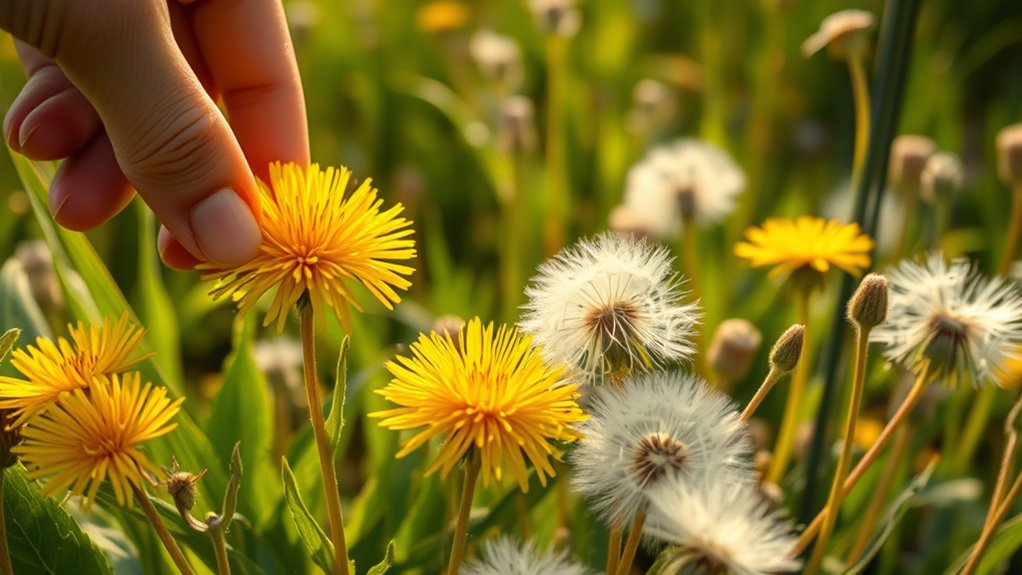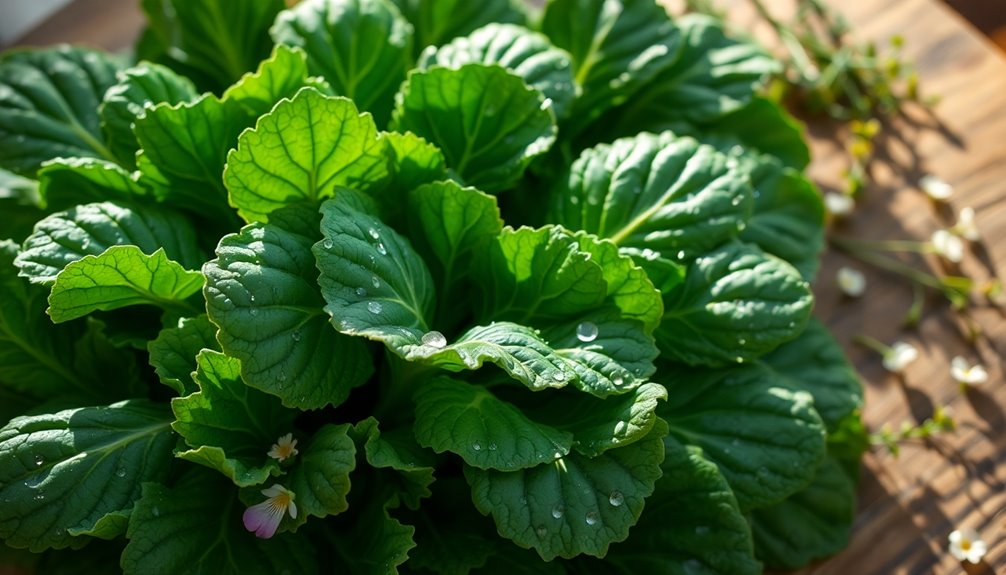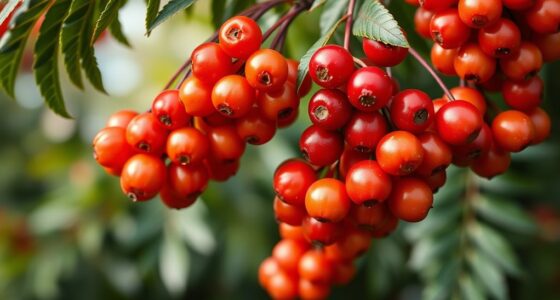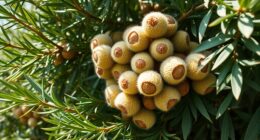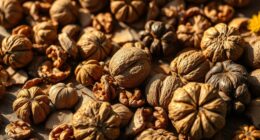To enjoy dandelion delights, learn to identify their distinctive leaves, bright yellow flowers, and seed heads, ensuring you harvest from clean, pesticide-free areas. Use sharp tools to gather greens, roots, and flowers, and handle them carefully for preservation—drying, freezing, or infusing. Incorporate these parts into teas, salads, sautés, or baked treats to boost nutrition and flavor. Continuing your journey will reveal creative recipes and essential tips for safe foraging and sustainable harvesting.
Key Takeaways
- Learn to identify dandelion parts—leaves, flowers, roots—and harvest responsibly from pollution-free areas for culinary and medicinal use.
- Incorporate dandelion greens into salads, sautés, or teas for their rich nutrients and health benefits like immune support and anti-inflammatory properties.
- Use flowers in dishes such as fritters, jams, or infused beverages, and process roots for teas or roasted coffee substitutes.
- Preserve dandelions by drying roots or freezing leaves and flowers for year-round use in infusions, powders, or culinary creations.
- Follow safe foraging practices: verify plant ID, avoid contaminated sites, wash thoroughly, and adhere to local regulations for sustainable harvesting.
Recognizing Dandelions in Nature
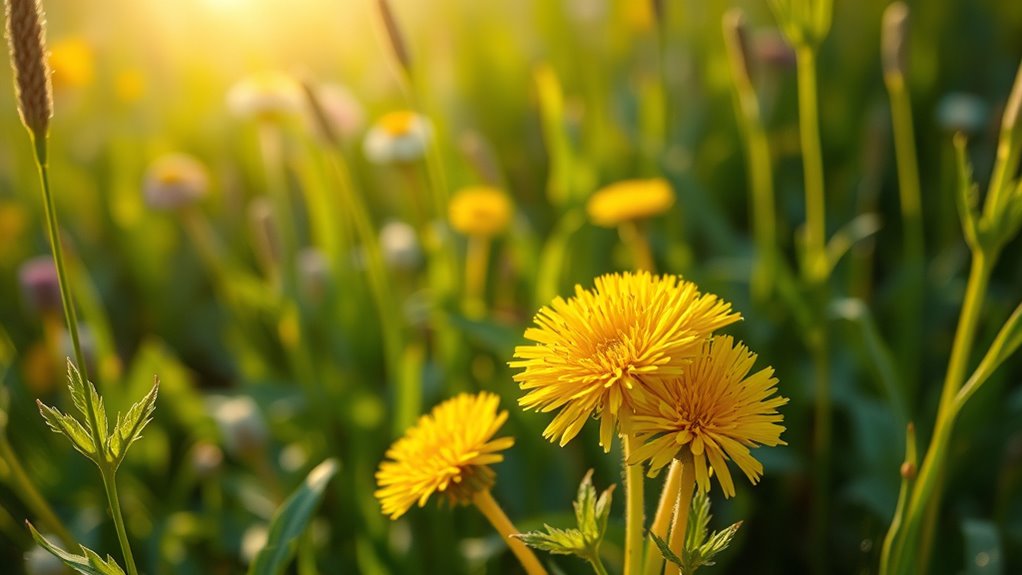
To recognize dandelions in nature, start by inspecting their distinctive leaves. They form a basal rosette at the bottom of the stem, with deeply toothed or lobed edges. When broken, the leaves emit a milky sap, a clear identification feature. The leaves are oblong to spatulate, ranging from 3 to 10 inches long, with the largest terminal lobe and smaller lobes towards the base. Young leaves are yellow-green, turning greener above and grayish-green below as they mature. Dandelion flowers are bright yellow and grow on single, hollow, unbranching stems. The seed heads are iconic white puffballs, perfect for seed dispersal. Recognizing these traits helps you confidently identify dandelions in various habitats worldwide. Additionally, understanding the leaf structure of dandelions can further assist in accurate identification across different environments. The leaf shape varies slightly depending on the growing conditions, which can also aid in identification. A knowledge of plant morphology enhances your ability to distinguish dandelions from similar-looking plants in diverse settings, especially when considering their growth patterns in different climates.
Best Practices for Foraging Safely
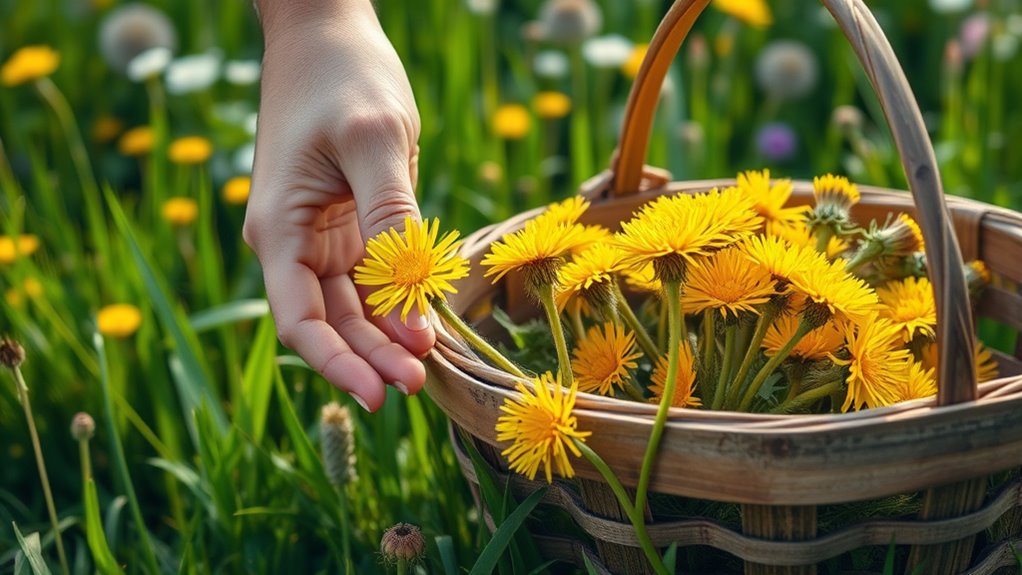
Practicing safe foraging starts with choosing the right locations, as environmental conditions directly affect plant safety and quality. Always pick areas away from roads and industrial sites to avoid pollutants, and steer clear of places treated with pesticides or herbicides. Look for sites with minimal human impact and easy access, while also respecting nearby ecosystems. The incident of a Microsoft outage demonstrates how reliance on technology can impact daily activities, reminding foragers to stay alert and prepared when venturing into remote areas. Ethical foraging means harvesting only what you need, leaving enough of the plant for regrowth, and rotating locations to prevent overharvesting. Additionally, understanding projector technology can help in setting up a suitable environment for viewing, which is particularly beneficial if you’re creating a home cinema space. Water quality is another important factor, as water safety directly impacts the health and safety of foraged plants. Good water quality control ensures that the plants you collect are free from harmful contaminants. Before heading out, check local regulations to ensure you’re compliant with laws and restrictions. Use clean, sharp tools to minimize plant damage, and always wash foraged plants thoroughly before use. Wearing protective gear and being aware of potential hazards keeps you safe during your foraging adventures, and staying informed about environmental safety ensures that your foraging practices do not harm the surrounding ecosystem.
Harvesting and Preserving Dandelion Parts
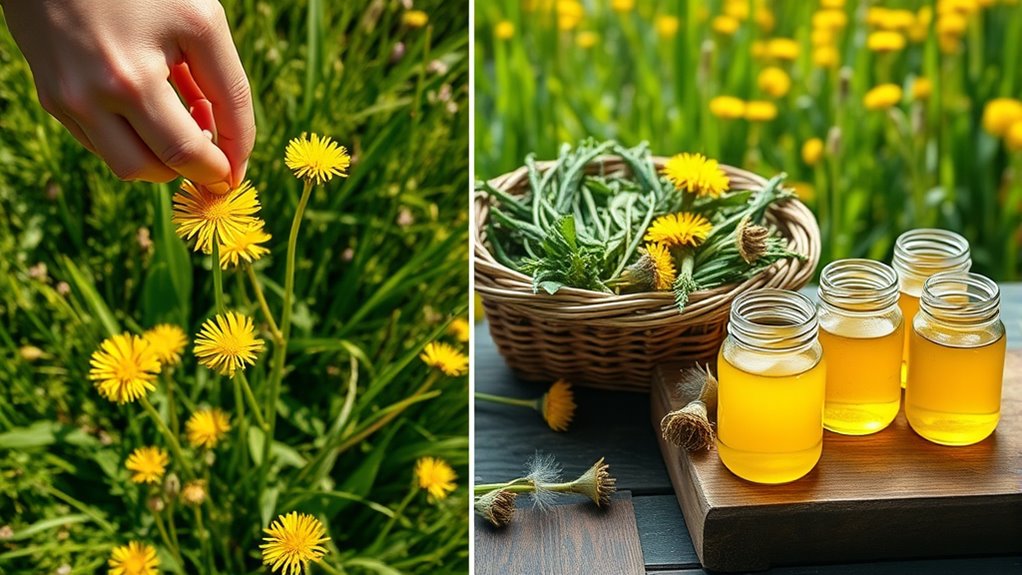
Harvesting and preserving dandelion parts requires careful timing and technique to guarantee quality and safety.
Careful timing and technique ensure safe, high-quality dandelion harvesting and preservation.
For leaves, pick early in spring when they’re tender, avoiding areas with pollution or chemicals. Use your hands or garden shears, and choose shaded spots for milder, less bitter greens. Proper harvesting timing ensures the best flavor and safety. Ensuring sustainable harvesting practices can help maintain healthy dandelion populations and prevent overharvesting. Being aware of currency fluctuations can also help when purchasing supplies or tools from international sources. Additionally, understanding local regulations on foraging can help prevent legal issues and promote responsible harvesting. Incorporating nutritional information about dandelions can encourage more mindful harvesting to maximize health benefits.
Flowers should be harvested from mid-spring to summer, ensuring they’re free of dust and debris; wear gloves to prevent staining from the milky sap.
Roots can be dug up anytime, especially in well-drained soil, and must be scrubbed clean.
To preserve, dry roots for storage or freeze leaves and flowers for future use.
Dandelion parts can also be infused into liquids or ground into powders, extending their shelf life and culinary potential.
Delicious Ways to Prepare Dandelion Flowers and Greens
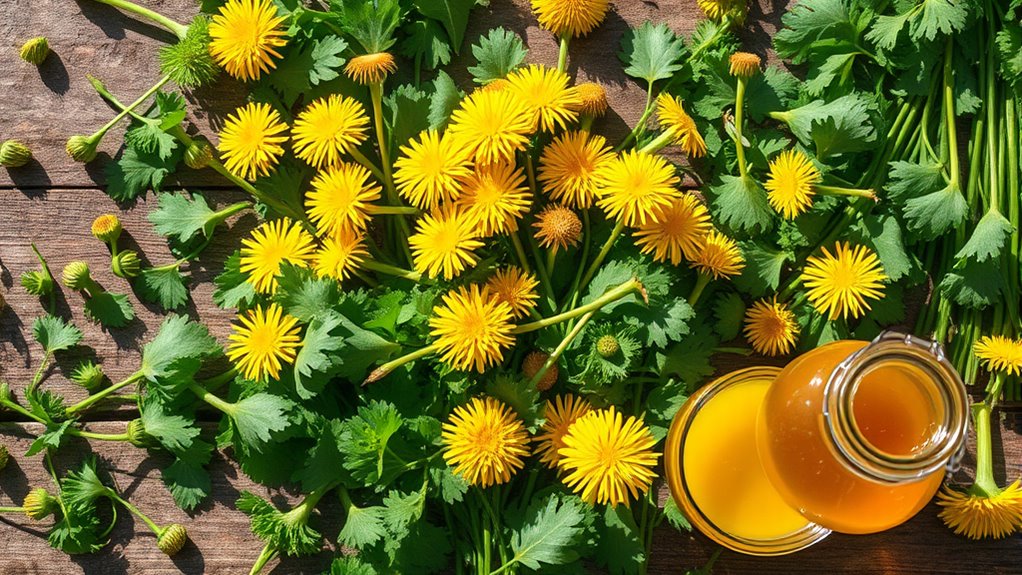
Dandelion flowers and greens offer a versatile and nutritious addition to your culinary repertoire. You can sauté greens with garlic and olive oil, adding red pepper flakes or lemon for extra flavor. Blanch greens for two minutes beforehand to calm their bitterness. Steaming retains nutrients and makes greens milder; add garlic and lemon for a fresh taste. Raw greens are perfect for salads, providing a peppery punch and high fiber, especially when chopped or massaged. Dandelion flowers shine in fritters, teas, wines, or jams, offering floral notes and health benefits. Incorporating nutritional benefits of dandelions can enhance your understanding of their positive effects on health. The robustness of dandelion greens can be affected by cybersecurity threats, so proper handling and sourcing are essential. Combining electric bike features, such as motor power and battery capacity, can influence how you incorporate these greens into energy-boosting smoothies or snacks. Combine sautéed greens with raw flowers for salads or infuse oils with both. Using these methods, you’ll enjoy dandelions in a variety of delicious, healthy dishes that highlight their unique flavors.
Creative Recipes Using Dandelion Roots and Seed Heads
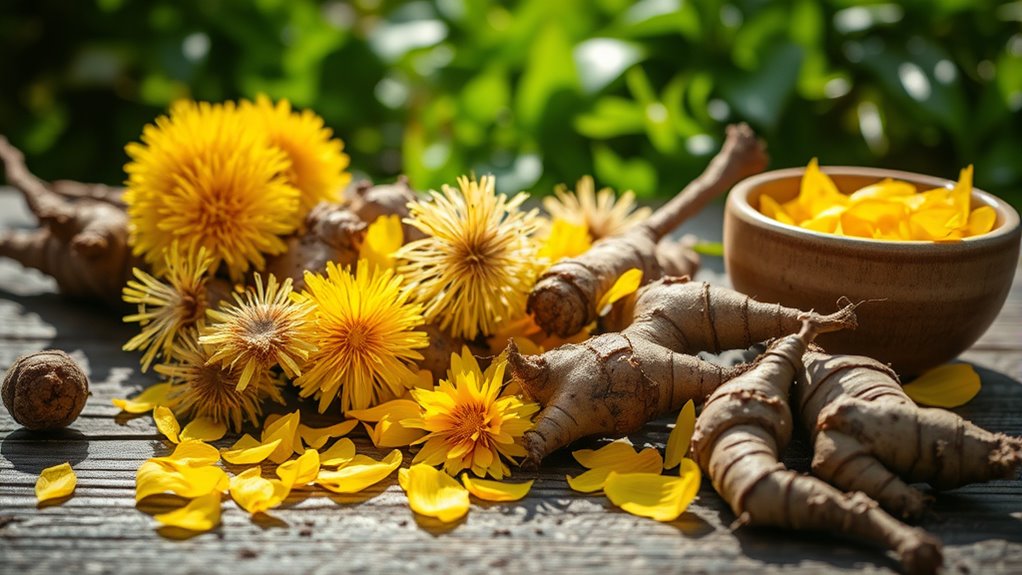
Exploring creative ways to use dandelion roots and seed heads can add unique flavors and health benefits to your culinary repertoire. You can roast or boil dandelion roots, making them similar to carrots or creating a rich, earthy side dish. Dried roots serve as a coffee substitute or can be simmered into a flavorful tea, sometimes enhanced with butter for extra richness. Adding green juice to your diet can further boost the nutrient content and support overall health. Incorporating nutrient-rich ingredients can maximize the health benefits of your recipes. Pickled roots offer a tangy snack, while infused vinegars turn into medicinal tonics. Seed heads lend themselves to inventive recipes like seed-infused granola, nutty seed crackers, or even seed-based beverages such as mead or tinctures. Seeds can also be processed into teas or roasted for a coffee alternative, making the most of this versatile, underappreciated plant part.
Nutritional Benefits and Health Highlights of Dandelions
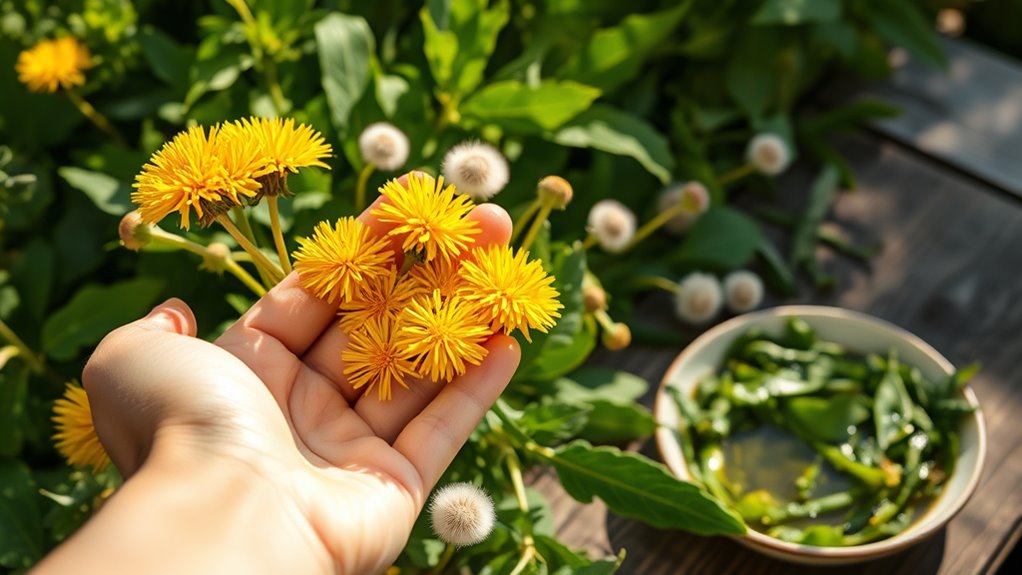
Dandelions aren’t only versatile for culinary uses but also pack a powerful nutritional punch. You’ll find they’re loaded with antioxidants like polyphenols and beta carotene, which help neutralize harmful free radicals and reduce chronic disease risk.
Their greens provide vitamins A, C, K, E, and folate, supporting your immune system and overall health. Dandelions are rich in essential minerals such as iron, calcium, magnesium, and potassium—crucial for various bodily functions.
The roots contain inulin, a fiber that promotes gut health and digestion. With only about 25 calories per cup of greens, they’re a nutrient-dense addition to your diet.
Their antioxidant and anti-inflammatory properties also help manage blood pressure, blood sugar, and cholesterol, contributing to heart health and disease prevention.
Frequently Asked Questions
Can Dandelions Be Safely Eaten Raw From Urban Environments?
You might wonder if you can safely eat raw dandelions from urban areas. While they’re edible, you should be cautious because urban dandelions can carry pollutants like pesticides or heavy metals.
Always thoroughly wash the greens in clean water to reduce dirt and contaminants. Avoid foraging from roadside or heavily polluted zones.
When in doubt, opt for parks known to be maintained without chemicals, and remember to prioritize safety.
Are There Any Medicinal Uses for Dandelion Roots Beyond Tea?
You’re wondering if dandelion roots have medicinal uses beyond tea. Yes, they do. You can use dried or fresh roots to make tinctures, extracts, or capsules, which may help improve liver function, stimulate appetite, support digestion, and reduce inflammation.
Traditional practices also use the roots to aid kidney health and detoxification. Always consult a healthcare professional before using dandelion roots medicinally to confirm safety and proper dosage.
How Can I Identify Dandelions in Winter or Early Spring?
You might think spotting a dandelion in winter or early spring is impossible, but with sharp eyes, you’ll notice their resilience shining through.
Look for lance-shaped leaves in a rosette, often toothed or lobed, emerging from the ground. Even under snow, their sturdy taproots and distinctive leaves stand out.
They thrive in disturbed areas, lawns, and cracks, appearing early when conditions are just right, proving nature’s unstoppable persistence.
What Are Common Pests or Diseases That Affect Dandelions?
You should watch for pests like aphids, which feed on dandelion sap, and wasps attracted to the nectar. Bees and butterflies visit for pollination, while beetles seek pollen.
Diseases like powdery mildew cause a white coating on leaves, and root rot results from overwatering.
Soil pests like wireworms and nematodes can damage roots.
Prevent these issues with crop rotation, proper watering, mulching, and timely removal of infected plants.
Is It Safe to Mix Dandelions With Other Foraged Plants in Recipes?
You might find it surprising, but mixing dandelions with other foraged plants in recipes is generally safe if you follow proper identification and safety steps.
You should verify all plants are correctly identified, free from pesticides, and healthy. Combining flavors like wild garlic or mustard greens can enhance your dish.
Just remember to wash everything thoroughly, respect local regulations, and practice sustainable harvesting to enjoy safe, delicious, and nutritious foraged meals.
Conclusion
Now that you know how to identify, harvest, and cook with dandelions, why not give it a try? These versatile plants can add flavor and nutrition to many dishes, turning weeds into wonderful ingredients. Are you ready to embrace the wild side of cooking and enjoy the many benefits dandelions offer? With a little practice, you’ll find yourself loving these garden treasures more than ever. So go ahead—dandelion delights await!

